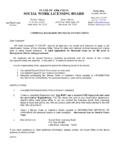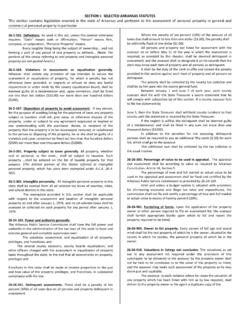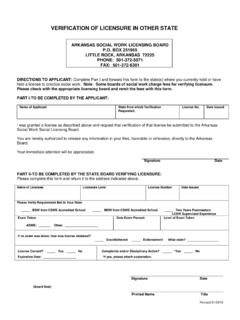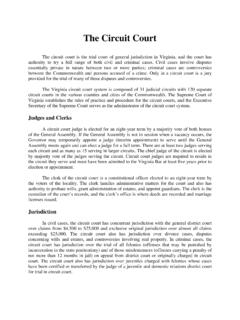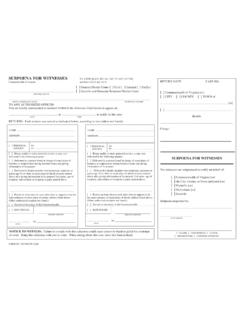Transcription of 1. SENTENCING ORDER - Arkansas
1 1. SENTENCING ORDER . What is the SENTENCING ORDER and what does it do? The SENTENCING ORDER ( ORDER ) replaces and combines the former Judgment and Commitment, Judgment and Disposition, and Departure Report forms. Its purpose is to document the disposition of criminal cases processed in the State's circuit courts. It provides the Arkansas Department of Correction (ADC) and the Arkansas Department of Community Correction (ACC). with the legal basis for the custody and community supervision of an offender. Courts are required to use the ORDER as of January 1, 2012. See 16-90-402 and 16-90- 801(d)(11)(B). Pursuant to Arkansas Supreme court Administrative ORDER Number 8 (Forms for Reporting Case Information in all Arkansas Trial Courts), where the final disposition results in a commitment to ADC, probation, suspended imposition of sentence, commitment to the ACC or to the county jail, a fine, restitution, and/or court costs, the office of the prosecuting attorney shall be responsible for completion of the ORDER , which shall be submitted to the circuit judge for signature, and filed in the Office of the Circuit Clerk.
2 Where the case is dismissed or nolle prossed because of the speedy trial rule, the case is transferred, or the defendant is acquitted, the office of the prosecuting attorney shall be responsible for completion of the Reporting Form for Defense-Related Dispositions which shall be submitted to the circuit judge for signature and filed in the Office of the Circuit Clerk. A copy of the ORDER may be downloaded from the Administrative Office of the Courts (AOC) web site at A certified copy of the ORDER is to be delivered by the sheriff with the Defendant to the proper correctional department. Who developed it? A working group composed of members from the criminal justice community was established to develop the ORDER . 16-90-402 requires representatives from the ADC, the Arkansas Judicial Council, and the Arkansas Prosecuting Attorneys' Association to develop a standardized judgment and commitment form.
3 16-90-803 directed the Arkansas SENTENCING Commission (the Commission) and the AOC to develop and implement an integrated SENTENCING and departure form. The Act, however, did not repeal the provision in 16-90-402. How do I differentiate between incarceration in ADC and other sanctions on the ORDER ? For each offense, there is a section to indicate the Defendant's sentence. Each sentence option is listed within that section. See below for a discussion of when to use a particular sanction. Imposed: This option is to be used when an offender is sentenced to a term of incarceration. Check boxes indicate whether the imposed sentence is a term of incarceration in an ADC facility, a sentence to the ADC with a judicial transfer to an ACC.
4 Facility (Jud. Tran.), or a term of incarceration in a County Jail. Under the check boxes, indicate the number of months imposed. Please note: The imposed sentence includes only time for which the offender is incarcerated. It does not include suspended imposition of sentence. 5-4-104(e)(1)(B)(ii) prohibits the suspension of the execution of a sentence. Probation: This option is to be used when an offender is placed on probation. Indicate the number of months on probation. If a sentence of probation includes a term of incarceration (Probation/SIS Plus), the ORDER has a section for entering the amount of incarceration time in either days or months. SIS: This option is to be used when the offender is placed on Suspended Imposition of Sentence.
5 If a sentence of SIS includes a term of incarceration (Probation/SIS Plus), the ORDER has a section for entering the amount of incarceration time in either days or months. Other: This option is to be used when an offender receives a sentence of Life, Life Without Parole (LWOP), or Death. If the offender receives a death sentence, enter the execution date pronounced in court in the Sentence Options section. SENTENCING ORDER Elements The following are some helpful tips for completing the SENTENCING ORDER . Instructions for completing the SENTENCING ORDER may be found at: publications/ court -forms/criminal-divisi on. Division: Enter the number that corresponds to the judge who is presiding over the case. Offender: Enter the name, date of birth, gender and race/ethnicity of the defendant.
6 Judge: Enter the name of the judge who signs the ORDER . Legal Statements: The statements in this section reflect the legal statements that appeared on the previous judgment forms. The first box applies when a defendant is sentenced pursuant to Act 346, the First Offender Act ( 16-93-301 et. seq.). or any other statute where the court defers further proceedings without entering a judgment of guilt. The second box applies when a defendant is placed on probation, probation/SIS plus, or other alternative sanction. This statement previously appeared on the Judgment and Disposition Form. The third box applies when a defendant is sentenced to a term of incarceration in the ADC or ACC facility via judicial transfer. This statement previously appeared on the Judgment and Commitment Form.
7 State Identification Number (SID): While the SID is not legally required, it may be obtained from the criminal information sheet or the local law enforcement agency handling the case. This is important to include (if you have it) because it ties the offense information to the offender. # of Offense/Name of Offense: Enter the code section in effect at the time the offense was committed. Use subsections if the offense was created or modified during or after the 2011 Legislative Session. Arrest Tracking Number (ATN): Each arrest will have a different ATN. It is important to include the ATN for each offense listed on the ORDER . The Arkansas Crime Information Center (ACIC) needs this information to tie the offense to the offender.
8 This information is also used by police officers in the field when making arrests. If there is no ATN, the information on offenses committed will be unavailable to the officer. Probation/SIS Revocation: This section indicates if a particular conviction is the result of a probation or SIS revocation. Check yes or no for every offense. An affirmative answer to this question applies to the current offense only and not to any new crime committed while on probation or parole. Also, if the commitment is the result of a probation revocation, the seriousness level must still be entered. Although the SENTENCING guidelines are not applicable to revocations, transfer eligibility is still determined by the seriousness level of the offense.
9 (Please note: Do NOT enter the code section for probation/SIS revocation in the Number of Offense/Name of Offense section. Enter the code section for the substantive offense and then check the appropriate box for probation/SIS revocation.). Offense Date: Enter a date for all offenses listed on the ORDER , even if the offense is Nolle Prossed or Dismissed. Release eligibility is determined by the date of the offense. Without it, an offender's release date cannot be determined. Criminal History Score & Seriousness Level: Criminal history scores and seriousness levels should be calculated on all felony offenses. The seriousness level for misdemeanors may be left blank. Calculate criminal history scores prior to plea negotiations.
10 A copy of the Criminal History Worksheet and instructions for completing the worksheet is available online at See 16-90-803(b)(2). Inchoate Offenses: Citing the inchoate statute instead of the statute for the substantive offense does not give sufficient information as to why the person is being convicted. In this situation, indicate the substantive statute in the Number of Offense/Name of Offense section of the ORDER and check the appropriate box identifying the inchoate offense committed. Defendant Sentence: An Imposed Sentence is when a person is sentenced to incarceration in an ADC facility, the ACC via judicial transfer, or county jail. Probation/SIS Plus: Do not use the space for the Imposed Sentence to indicate incarceration time for a sentence of probation plus a period of confinement.
